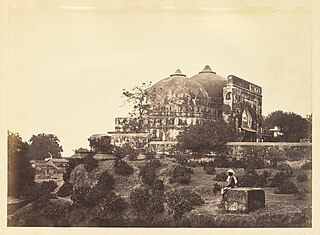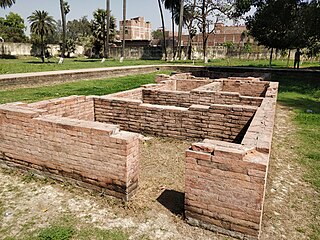Related Research Articles

Babri Masjid was a mosque in Ayodhya, India. It has been claimed to have been built upon the site of Ram Janmabhoomi, the legendary birthplace of Rama, a principal deity of Hinduism. It has been a focus of dispute between the Hindu and Muslim communities since the 19th century. According to the mosque's inscriptions, it was built in 1528–29 by Mir Baqi, a commander of the Mughal emperor Babur. Before the 1940s, the masjid was officially known as "Masjid-i-Janmasthan". The mosque was attacked and demolished by a Hindu nationalist mob in 1992, which ignited communal violence across the Indian subcontinent.
Ram Janmabhoomi is the site that, according to Hindu religious beliefs, is the birthplace of Rama, the seventh avatar of the Hindu deity Vishnu. The Ramayana states that the location of Rama's birthplace is on the banks of the Sarayu river in a city called "Ayodhya". Modern-day Ayodhya is in the north Indian state of Uttar Pradesh. It is contested whether the Ayodhya mentioned in the Ramayana is the same as the modern city.

Patna Museum is the state museum of the Indian state of Bihar. Founded on 3 April 1917 during the British Raj to house the historical artefacts found in the vicinity of Patna, it is constructed in the style of Mughal and Rajput architecture, and is known locally as the Jadu Ghar. Artefacts from the ancient India era to 1764 have now been transferred to Bihar Museum.

Braj Basi Lal was an Indian writer and archaeologist. He was the Director General of the Archaeological Survey of India (ASI) from 1968 to 1972 and has served as Director of the Indian Institute of Advanced Studies, Shimla. Lal also served on various UNESCO committees.

Swaraj Prakash Gupta was a prominent Indian archaeologist, art historian authority, Chairman of Indian Archaeological Society, founder of the Indian History and Culture Society, and Director of the Allahabad Museum. He was most noted for several excavations Indus Valley civilisation sites and for his support of the existence of a destroyed Ram Mandir underneath the Babri Masjid in Ayodhya.
The archaeology of Ayodhya concerns the excavations and findings in the Indian city of Ayodhya in the state of Uttar Pradesh, much of which surrounds the Babri Mosque location.

Ram Sharan Sharma was an Indian historian and Indologist who specialised in the history of Ancient and early Medieval India. He taught at Patna University and Delhi University (1973–85) and was visiting faculty at University of Toronto (1965–1966). He also was a senior fellow at the School of Oriental and African Studies, University of London. He was a University Grants Commission National Fellow (1958–81) and the president of Indian History Congress in 1975. It was during his tenure as the dean of Delhi University's History Department that major expansion of the department took place in the 1970s. The creation of most of the positions in the department were the results of his efforts. He was the founding Chairman of the Indian Council of Historical Research (ICHR) and a historian of international repute.

The Ayodhya dispute is a political, historical, and socio-religious debate in India, centred on a plot of land in the city of Ayodhya, Uttar Pradesh. The issues revolve around the control of a site regarded since at least the 18th century among many Hindus to be the birthplace of their deity Rama, the history and location of the Babri Masjid mosque at the site, and whether a previous Hindu temple was demolished or modified to create the mosque.

Kumhrar or Kumrahar is the area of Patna where remains of the ancient city of Pataliputra were excavated by the Archaeological Survey of India starting from 1913. It is located 5 km east of Patna Railway Station.
Anant Sadashiv Altekar was a historian, archaeologist, and numismatist from Maharashtra, India. He was the Manindra Chandra Nandy's Professor and Head of the Department of Ancient Indian History and Culture at Banaras Hindu University in Varanasi, India, and later the director of the Kashi Prasad Jayaswal Research Institute and University Professor of Ancient Indian History and Culture at the Patna University, both in Patna, India.
Kishore Kunal is a former officer of the Indian Police Service from the state of Bihar, India. During his police career, he was appointed as the Officer on Special Duty (Ayodhya) by the prime minister V. P. Singh to mediate between the Vishwa Hindu Parishad and the Babri Masjid Action Committee on the Ayodhya dispute. He continued to serve in this position during the premierships of Chandra Sekhar and P. V. Narasimha Rao.

The demolition of the Babri Masjid was carried out on 6 December 1992 by a large group of activists of the Vishva Hindu Parishad and allied organisations. The 16th-century Babri Masjid in the city of Ayodhya, in Uttar Pradesh, India, had been the subject of a lengthy socio-political dispute, and was targeted after a political rally organised by Hindu nationalist organisations turned violent.
Ram Janmabhoomi Nyas is an organisation which was formed as a trust to promote and oversee the construction of a temple in Ayodhya, India at the Ram Janmabhoomi, the reputed site of the birth of the Hindu deity Rama. The Nyas was formed by members of the Vishva Hindu Parishad.

Kashi Prasad Jayaswal was an Indian historian and lawyer. Jayaswal's works Hindu Polity (1918) and History of India, 150 A.D. to 350 A.D. (1933) are classics of ancient Indian historical literature. Among other things, he is credited with showing that Indian republics, based on principles of representation and collective decision-making, were among the most democratic polities of the ancient world.

Patna College is a constituent state aided College of Patna University which was established in 1863 during the British Raj. It offers undergraduate and postgraduate courses in science, arts and commerce as well as some vocational courses like BBA, BMC and BCA. The college is affiliated to Patna University. It is also considered to be the oldest institution of higher education in Bihar.

The Bhagalpur violence of 1989 took place between Hindus and Muslims in the Bhagalpur district of Bihar, India. The violence started on 24 October 1989, and the violent incidents continued for 2 months, affecting the Bhagalpur city and 250 villages around it. Over 1,000 people were killed, and another 50,000 were displaced as a result of the violence. It was the worst instance of Hindu-Muslim violence in independent India at the time.

The Ram Rath Yatra was a political and religious rally that lasted from September to October 1990. It was organised by the Bharatiya Janata Party (BJP) and its Hindu nationalist affiliates, and led by the then-president of the BJP, L. K. Advani. The purpose of the yatra was to support the agitation, led by the Vishwa Hindu Parishad (VHP) and its affiliates in the Sangh Parivar, to erect a temple to the Hindu deity Rama on the site of the Babri Masjid.

Suraj Bhan (1931–2010) was an Indian archaeologist and professor of archaeology. His academic work was said to bear a deep imprint of Marxism. He was also involved with the work of Communist Party of India (Marxist) in Haryana and took particular interest in the People's Science movement.

Karingamannu Kuzhiyil Muhammed is an Indian archaeologist who served as the Regional Director (North) of the Archaeological Survey of India (ASI). Muhammed is credited for the discovery of Ibadat Khana, as well as various prominent Buddhist Stupas and Monuments. During his career, he undertook the restoration of the Bateshwar Complex, successfully convincing naxal insurgents and dacoits to cooperate, as well as facelift and restoration of the Dantewada and Bhojeshwar temples.

The Ram Mandir is a partially constructed Hindu temple complex in Ayodhya, Uttar Pradesh, India. Many Hindus believe that it is located at the site of Ram Janmabhoomi, the mythical birthplace of Rama, a principal deity of Hinduism. The temple was inaugurated on 22 January 2024 after a prana pratishtha (consecration) ceremony. On the first day of its opening, following the consecration, the temple received a rush of over half a million visitors, and after a month, the average number of visitors was reported to be "1 to 1.5 lakh on a daily basis".
References
- 1 2 B. P. Sinha Dead [ dead link ]; article; 4 May 2002; The Hindu; retrieved October 2015.
- 1 2 K. N. Dikshit (2002). K. N. Dikshit and K. S. Ramachandran (ed.). "Obituaries: B. P. Sinha". Purātattva (32). Indian Archaeological Society: vi.
- ↑ ASI to develop ancient site of Vikramshila Mahavihara, The Times of India, 10 October 2009.
- ↑ B. P. Sinha, Archaeological Evidences of Ram Janmabhoomi; Text: Evidence For The Ram Janmabhoomi Mandir; Presented to the Government of India; 23 December 1990; Hindu Vivek Kendra; retrieved 2015-05-03.